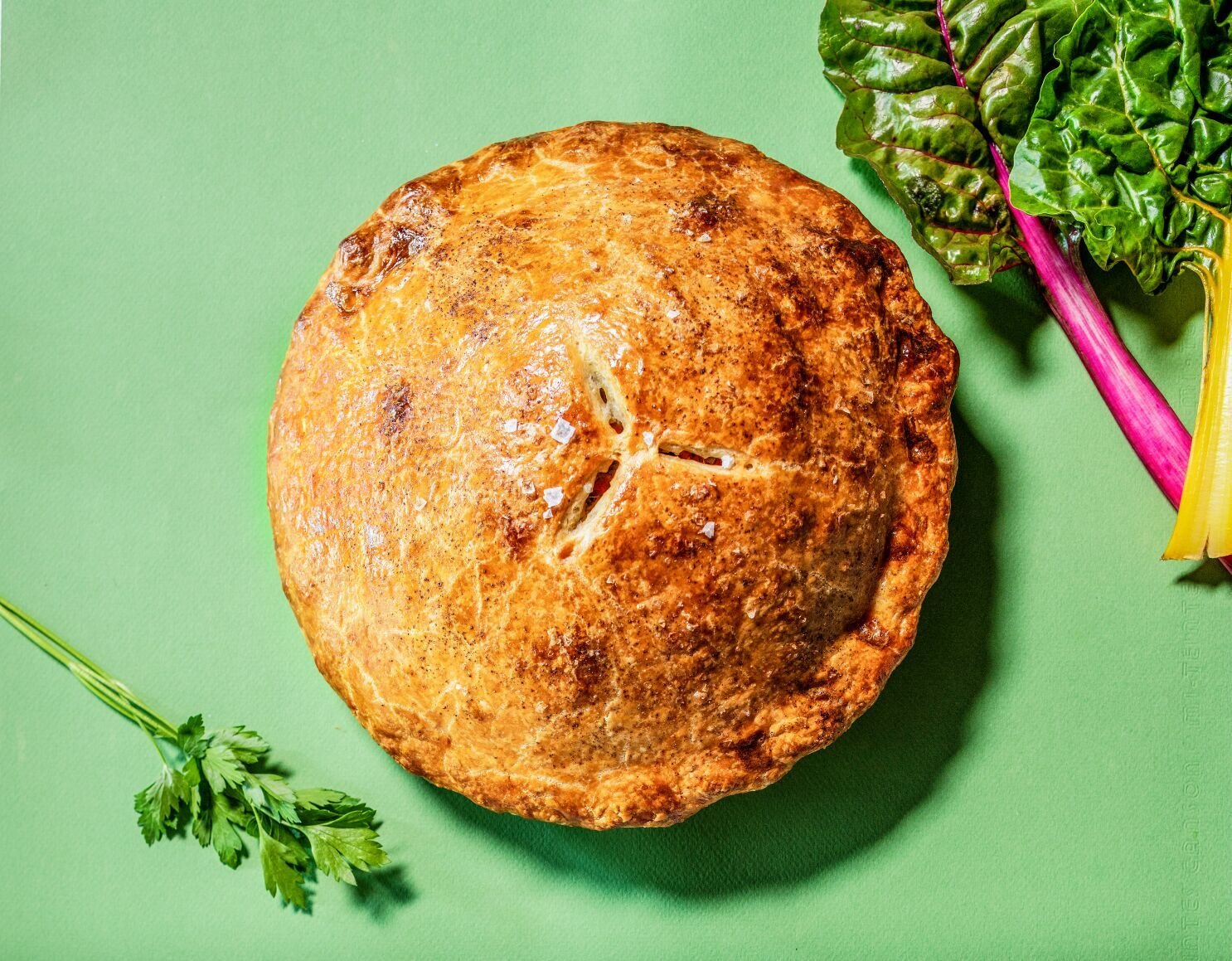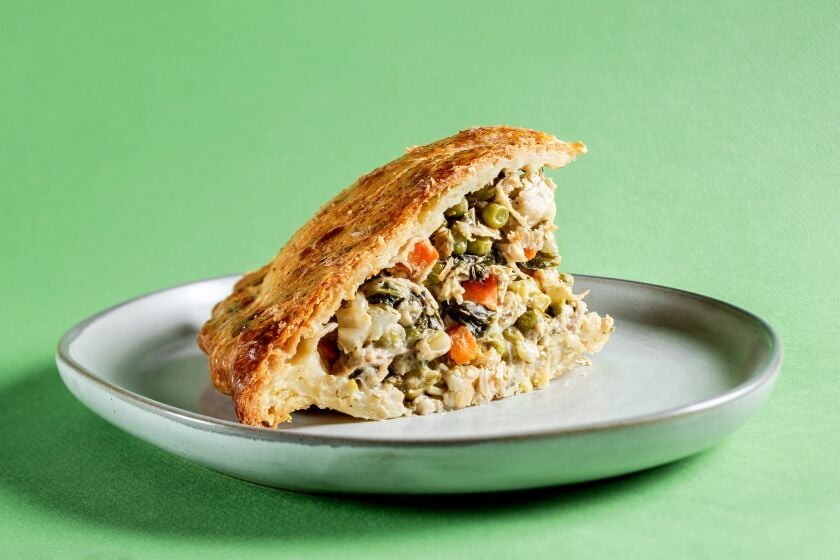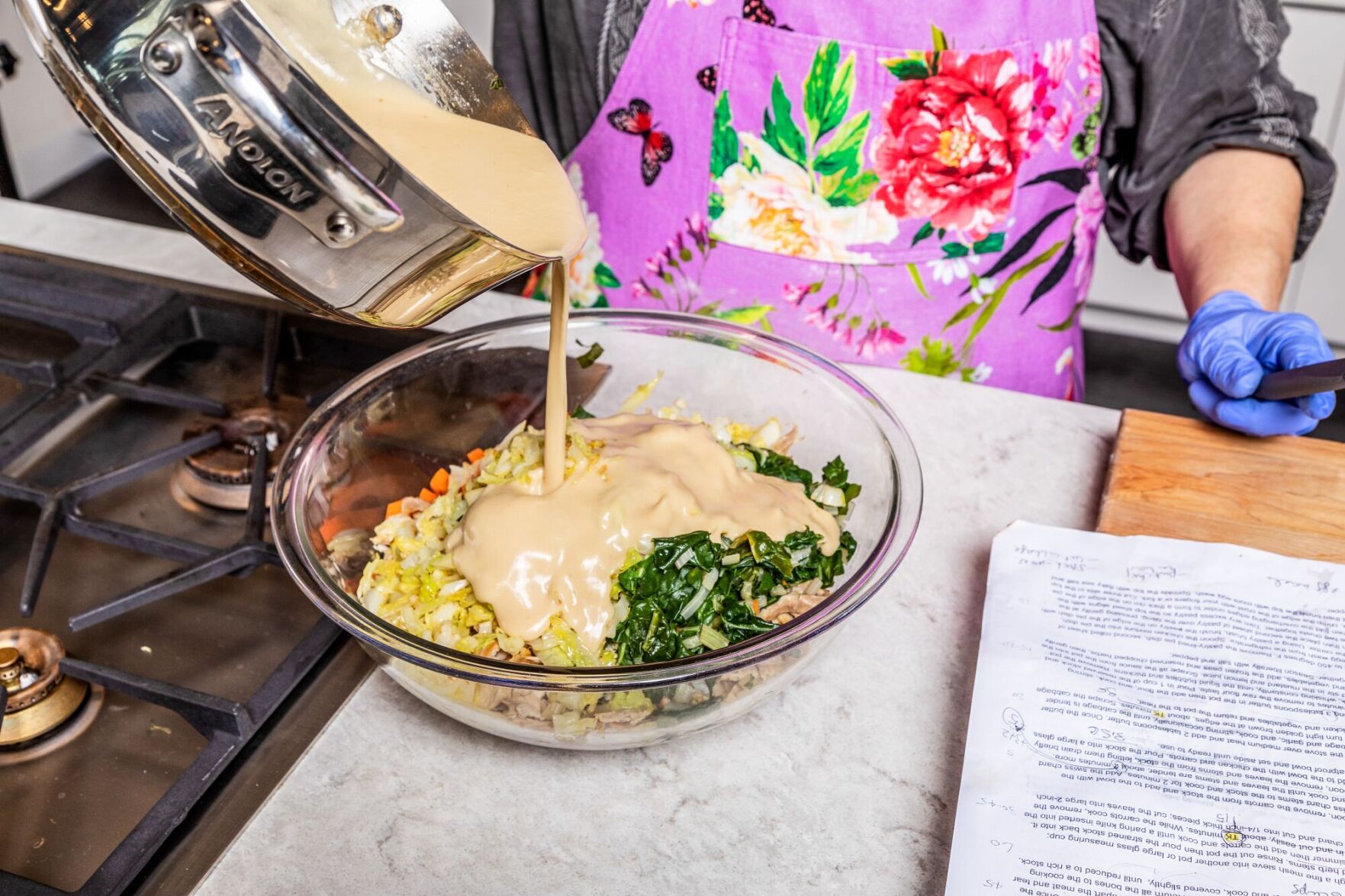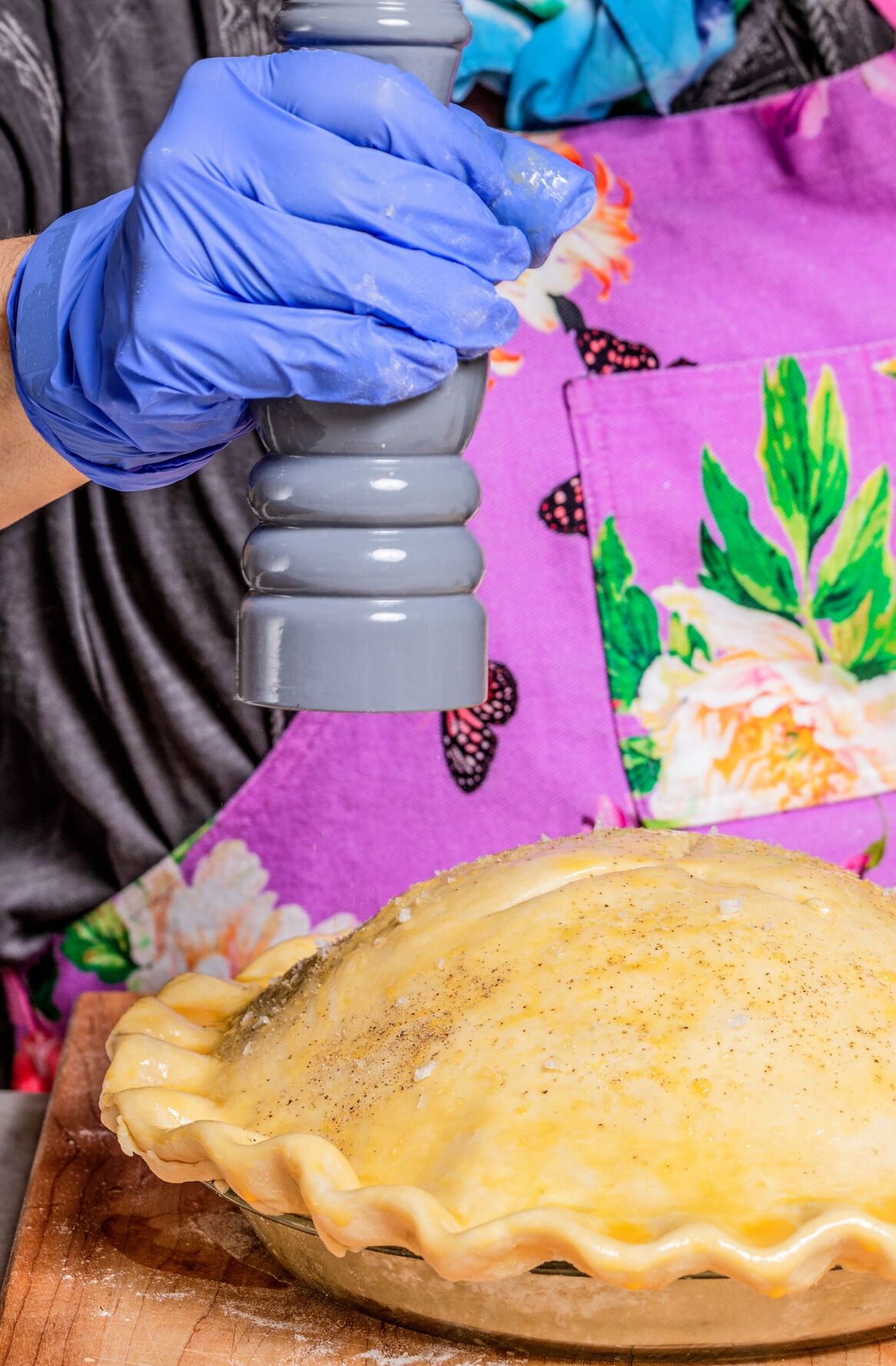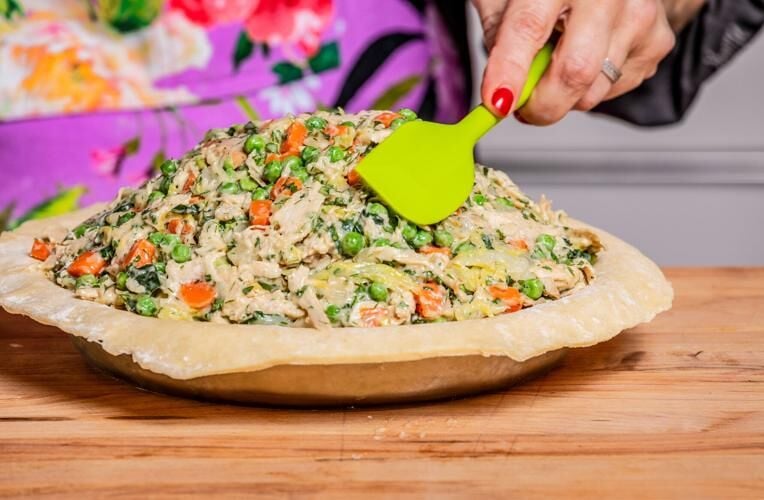I recently had an epiphany about, of all things, chicken potpie. A few weeks ago, my partner and I set out for a walk into Griffith Park from our apartment. In the mood for adventuring, we started taking every turn we hadn’t before and soon enough we found ourselves on the back of a hill, practically holding onto the vertical edge like rock climbers.
I looked up and saw the very top of the “D” in the Hollywood sign and suggested that we walk to the sign since we were already “so close.” By the time we reached it, we had trekked six miles, were starving and were very annoyed. To make matters worse, our only way out was a four-mile hike down the hill.
We found a restaurant on Franklin Boulevard and decided to stop to eat for the first time all day. And by “decided,” I mean our hobbling legs and numb feet would take us no farther than the first available place with empty chairs outside.
After we ordered our food, two giant, piping-hot chicken potpies were delivered to the table behind us. A woman walking by stopped midstride, took off her headphones and asked one of the guys, “What is that you’re eating?” The customer responded, “a chicken potpie,” and the woman exclaimed, “it looks so abundant.” FOMO set in immediately for both my partner and me: We wished we had ordered those chicken potpies for our weary, tired souls.
I’ve thought about an “abundant” chicken potpie ever since, and although it might not be a dish you think about this time of year, it can be comforting when morning and night temps hover below 70 degrees and the skies of early spring and summer are gloomy and gray.
One of the ways to keep the potpie from feeling too heavy and rich is by packing in more fresh green vegetables than in classic recipes, which, let’s be honest, haven’t changed much in decades. The cooked carrots and peas are my favorite part of classic chicken potpie, but there are other things that pair equally well with poached chicken and seasoned gravy in a flaky pie crust.
Herbs are an easy first step. Parsley is a mainstay of the classic, but I like to add more than usual and also throw in dill and chives for their greenness and freshness. Swiss chard and sautéed cabbage, while both may not scream “summer,” provide extra greens that toe the line between light and bulking — perfect for a filling such as this. And in the gravy, instead of adding cream as many classic recipes do, I use milk and stir in a spoonful of Dijon mustard and lemon juice, which also helps cut the weight of the dish and perk up the other ingredients.
It’s the perfect weekend project dish: Make the pie crust on a Saturday morning, poach the chicken and prepare the filling that afternoon, then bring everything together and toss in the oven for Sunday lunch or dinner. It’s a veggie-packed pie that feels both comforting and genuinely nourishing — the perfect dish to come back to for leftovers the rest of the week.
To me, it’s like reaching for those Marie Callender’s individual potpies — which I admit I love — in the freezer section to provide instant comfort, regardless of the temperatures outside. And in reworking a comforting classic, this chicken potpie is worthy of the name that awe-struck passerby gave it.
Abundant Chicken Pot Pie
Time: 4 hours, 30 minutes.
Yields: Serves 6 to 8.
1 recipe (2 disks) Basic Pie Pastry Dough (see recipe), chilled1 large egg1 tablespoon water1 bunch flat-leaf parsley1 small bunch dill1 small bunch chives1 whole chicken, preferably 3 to 4 pounds (or bone-in, skin-on breast pieces of equal weight)1 medium yellow onion, roughly chopped2 medium carrots, peeled and cut into ½-inch pieces1 bunch Swiss chard5 tablespoons unsalted butter, divided¼ cabbage, cored and thinly sliced2 large garlic cloves, minced¼ cup all-purpose flour1 cup whole milk1 tablespoon fresh lemon juice1 tablespoon Dijon mustard1 bag (10 ounces) frozen peasKosher salt and freshly ground black pepperFlaky sea salt
Directions
1
On a floured work surface, roll one chilled dough disk until 1/8-inch thick. Transfer to a 9-inch glass or ceramic pie dish, leaving a 1-inch overhang all around and trimming any excess. Place the pastry-lined pie tin in the refrigerator. Repeat rolling the second dough disk and place on a parchment-paper-lined baking sheet; place it in the refrigerator, too.
2
In a small bowl, use a fork to mix together the egg and water to make an egg wash. Cover the bowl with plastic wrap and refrigerate until ready to use.
3
Make the filling. Chop enough parsley leaves to fill ¼ cup, and chop enough of the dill and chives to fill 2 tablespoons each. Place all the chopped herbs in a small bowl, cover with plastic wrap and refrigerate until ready to use. Place the remaining bunches of herbs and stems in a large saucepan. Add the chicken and onion, then pour in enough cold water to just cover the chicken. Bring to a boil over high heat, then reduce the heat to maintain a gentle simmer and cook until an instant-read thermometer inserted in the thigh of the chicken reads 160 degrees, about 30 minutes.
4
Using tongs or a large spoon, lift the chicken from the pot, letting it drain briefly, then transfer to a cutting board. Remove the pot from the heat, but don’t disturb the cooking liquid. Once the chicken is cool enough to handle, remove and discard the skin, then pick apart the meat and tear into bite-size pieces; transfer all the meat to a large bowl. Return all the bones to the cooking liquid, then return the liquid to a simmer and cook, covered slightly, until reduced to a rich stock, about one hour.
5
Pour the stock through a fine mesh sieve into another pot or large glass measuring cup; discard the onions and herb stems. Rinse out the pot, then pour the strained stock back into it. Return the stock to a simmer, then add the carrots and cook until a paring knife inserted into the thickest pieces slides in and out easily, about 10 minutes. While the carrots cook, remove the stems from the Swiss chard and cut into ¼-inch-thick pieces; cut the leaves into large 2-inch pieces.
6
Using a slotted spoon, remove the carrots from the stock and add to the bowl with the chicken. Add the Swiss chard stems to the stock and cook for two minutes. Add the Swiss chard leaves to the stock and cook until the leaves and stems are tender, about two minutes more. Using the slotted spoon, remove the leaves and stems from the stock, letting them drain briefly over the pot, and add to the bowl with the chicken and carrots. Pour the stock into a large glass measuring cup or heatproof bowl and set aside until ready to use.
7
Return the pot to the stove over medium heat and add 2 tablespoons butter. Once the butter melts, add the cabbage and garlic, and cook, stirring occasionally, until the cabbage is tender and just starting to turn light golden brown at the edges, about four minutes. Scrape the cabbage into the bowl of chicken and vegetables and return the pot to the heat.
8
Melt the remaining 3 tablespoons butter in the pot, then add the flour and cook, stirring constantly, for two minutes to remove the raw flour taste. Pour in 1 cup of the reserved stock and the milk and cook, whisking constantly, until the liquid bubbles and thickens. Remove the pot from the heat and stir in the lemon juice and mustard. Scrape all the sauce from the pot into the bowl of chicken and vegetables, add the frozen peas and reserved chopped herbs, then gently stir everything together. Season liberally with salt and pepper.
9
Heat the oven to 450 degrees. Remove the pastry-lined pie dish, the second rolled sheet of pastry and the egg wash from the refrigerator. Spoon the chicken mixture into the pie dish, mounding it in the center. Using a pastry brush, brush the pastry on the edge of the pie dish with some egg wash, then place the second sheet of pastry over the filling, pressing gently at the edge to seal the two crusts together. Trim any excess pastry so the top sheet aligns with the bottom sheet, then fold the overhanging edges under to form a thick rim on the edge of the pie dish. If you like, crimp the edge of the crust with your fingers or a fork. Brush the top of the pie with egg wash, then cut three slits in the top of the pie crust. Sprinkle the top with flaky sea salt and more black pepper.
10
Place the pie dish on a parchment-paper- or foil-lined baking sheet and bake for 15 minutes. Reduce the oven temperature to 350 degrees, and continue baking the pie until the crust is deep golden brown all over and you can see the filling bubbling through the slits in the top crust, 35 to 45 minutes more. Remove the pie from the oven and let cool for at least 30 minutes before serving.
Basic Pie Pastry Dough
390 grams (2¾ cups) all-purpose flour,plus more for rolling and dusting2 tablespoons granulated sugar1 teaspoon fine sea salt226 grams (1 cup) unsalted butter,cut into ½-inch cubes and chilled2/3 cup ice-cold water
Directions
1
In a large bowl, whisk together the flour, sugar and salt. Add the butter and use your fingers to pinch and rub it into the flour repeatedly until pea-size crumbles form. Pour in the water and use a fork to toss (not stir) the butter-flour mixture until it’s evenly moistened.
2
Scrape the crumbly mass onto a clean work surface and pat and smush gently until it starts to form a solid piece of dough. Cut the dough in half, then flatten each piece into a disk, patting the edges to smooth them. Wrap each disk in plastic wrap and refrigerate for at least one hour or up to two days.
3
After two days, freeze the pastry to store long-term, letting it thaw for 1 day in the refrigerator before using.
Ben Mims writes for the Los Angeles Times.

